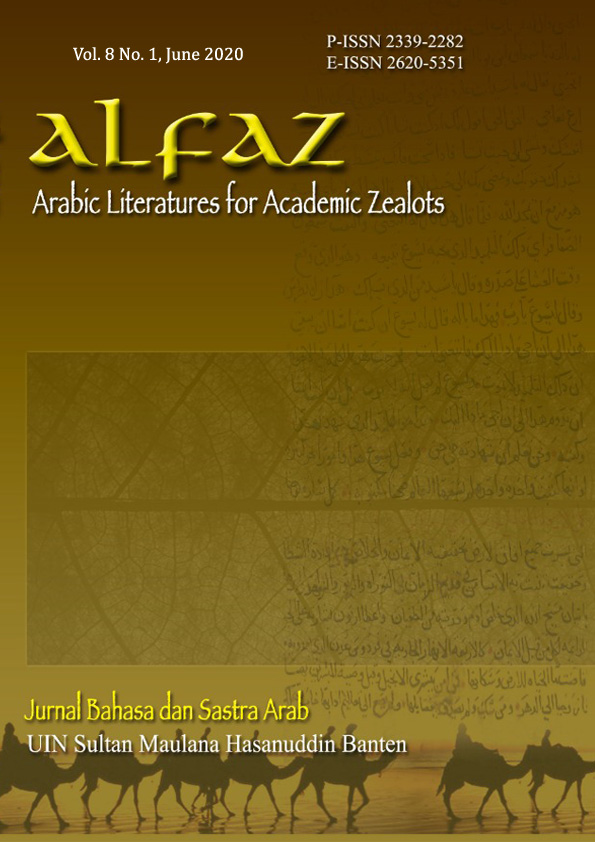Menelusuri Kata ‘‘Wabah‘‘ dan ‘‘Tho’un‘‘ dalam Korpora Diakronis Arab-Indonesia
DOI:
https://doi.org/10.32678/alfaz.Vol8.Iss1.2579Keywords:
Corpus Linguistics, Semantic Change, Lexicography, Arabic LoanwordAbstract
This study tries to trace the meaning of wabah and tho‘un as they are used in Arabic and Indonesian language. To do so, three diachronic corpora were utilized as resources. They are Malay Concordance Project corpora (MCP), Leipzig Corpora collection, and WebCorp. MCP was used to determine the word wabah and tho’un in pre-modern era. Leipzig corpora was used to demonstrate the collocation and concordance of the studied words. WebCorp was used to trace their used in the modern era and in more recent texts. This study revealed that wabah is originally from وباء, a word that is borrowed from Arabic waba‘. The used of wabak was found in 1500’s, in pre-modern texts. This word furthermore becomes wabah in modern uses. Unlike, the words tho‘un (read: ṭāʻūn) was unknow in the pre-modern era. In modern era, the word wabah and tho‘un are used in context related to health, not far from their original meaning. The findings of this study furthermore, pave the way for the importance use of corpus for the development of Indonesian words etymology and its lexicography.
Downloads
References
Berg, B., ‘’Presence and Power of the Arab Idiom in Indonesian Islamic Musical Arts‘’. Paper Presented at Conference on Music in the World of Islam. 8-13, August 2007.
Gallop, Annabel Teh., ‘’The Language of Malay Manuscript Art: A Tribute to Ian Proudfoot and the Malay Concordance Project‘’. International Journal of the Malay World and Civilisation. 1(3), 11-27, 2013.
Hartama, Kenji, ‘‘Wabah dan Penyakit Menular dalam Hadis Nabi‘‘. Diakses 28 April 2020 dari https://www.academia.edu/41933060/wabah-dan-penyakit-meular-dalam-hadis-nabi
Hilpert, M., & Gries, S. ‘’Quantitative Approaches to Diachronic Corpus Linguistics‘’. In M. Kyoto & P. Pahta (Eds.), the Cambridge Handbook of English Historical Linguistics, (Cambridge: Cambridge University Press, 2016).
Julul, Ali Ahmad, Rahmawati, N.M., Kwary, D.A., Sartini, N.W. ‘’Semantic Adaptations of the Arabic Loanwords in the Indonesian Language‘’. Mozaik Humaniora, 19(2), 135-147, 2019.
Kamus Besar Bahasa Indonesia. https://kbbi.kemdikbud.go.id/. Diakses 1 April 2020.
Manfredi, Stefano, Simeone-Senelle, Marie-Claude, Tosco, Mauro. ‘’Language Contact, Borrowing and Codeswitching‘’. In Amina Mettouchi; Martine Vanhove; Dominique Caubet. Corpus-Based Studies of Lesser-Described Languages: The Corpafroas Corpus of Spoken Afroasiatic Languages, 67, 283-308, John Benjamin, 2015.
NU Online, 2020, ‘‘Salah Kaprah Pengertian Thaun dan Wabah dalam Hadits Rasulullah SAW‘‘. Diakses 28 April 2020 dari https://www.islam.nu.or.id/post/read/118419/salah-kaprah-pengertian-thaun-dan-wabah-dalam-hadits-rasulullah-saw
Nur, T., ‘’Sumbangan Bahasa Arab terhadap Bahasa Indonesia dalam Perspektif Pengembangan Bahasa dan Budaya‘’, Humaniora, 26(2), 235–242, 2014.
Republika. 2020. ‘‘Apa Bedanya Tha’un dan Waba‘?‘‘. Diakses 28 April 2020 dari https://republika.co.id/berita/q8bgnt430/apa-bedanya-thaun-dan-waba
Ruskhan, A. G., Bahasa Arab dalam Bahasa Indonesia: Kajian tentang Pemungutan Bahasa, (Jakarta: Grasindo, 2007).
--------------------, Pungutan Bahasa Arab Laras Keagamaan dalam Bahasa Indonesia: Tinjauan Leksikal, Tesis, (Jakarta: Universitas Indonesia, 1995).
Syukri, H., Kesetiaan Bahasa Masyarakat Keturunan Arab, Tesis, (Depok: Universitas Indonesia, 1996).
van Dam, N., ‘’Arabic Loanwords in Indonesian Revisited‘’, Bijdragen tot de Taal-, Land- en Volkenkunde (BKI), 2/3(166), 218–243, 2010.
Zahra, Tehseen dan Abbas, Akhtar. ‘’Pedagogical Implications of Corpus-Based Approaches to ELT in Pakistan‘’. Journal of Education and Educational Development, 5(2), 259-275, 2018.
Almaany, https://almaany.com/. Diakses 1 April 2020.
Downloads
Published
Issue
Section
License
Authors retain copyright and grant the journal right of first publication with the work simultaneously licensed under a CC BY NC SA License that allows others to share the work with an acknowledgement of the work's authorship and initial publication in this journal.







